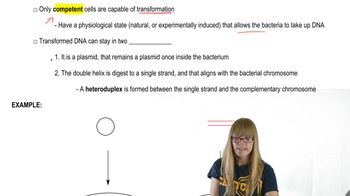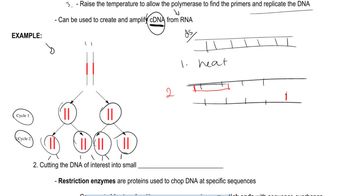Table of contents
- 1. Introduction to Genetics51m
- 2. Mendel's Laws of Inheritance3h 37m
- 3. Extensions to Mendelian Inheritance2h 41m
- 4. Genetic Mapping and Linkage2h 28m
- 5. Genetics of Bacteria and Viruses1h 21m
- 6. Chromosomal Variation1h 48m
- 7. DNA and Chromosome Structure56m
- 8. DNA Replication1h 10m
- 9. Mitosis and Meiosis1h 34m
- 10. Transcription1h 0m
- 11. Translation58m
- 12. Gene Regulation in Prokaryotes1h 19m
- 13. Gene Regulation in Eukaryotes44m
- 14. Genetic Control of Development44m
- 15. Genomes and Genomics1h 50m
- 16. Transposable Elements47m
- 17. Mutation, Repair, and Recombination1h 6m
- 18. Molecular Genetic Tools19m
- 19. Cancer Genetics29m
- 20. Quantitative Genetics1h 26m
- 21. Population Genetics50m
- 22. Evolutionary Genetics29m
18. Molecular Genetic Tools
Genetic Cloning
Problem 31b
Textbook Question
You have cloned a gene for an enzyme that degrades lipids in a bacterium that normally lives in cold temperatures. You wish to transfer this gene into E. coli to produce industrial amounts of enzyme for use in laundry detergent. How would you accomplish this?
 Verified step by step guidance
Verified step by step guidance1
Identify the gene of interest that codes for the enzyme responsible for degrading lipids in the cold-adapted bacterium.
Isolate the gene using molecular techniques such as PCR (Polymerase Chain Reaction) to amplify the specific DNA sequence.
Insert the isolated gene into a plasmid vector that is compatible with E. coli. This can be done using restriction enzymes to cut the plasmid and ligase to insert the gene.
Transform the recombinant plasmid into E. coli cells through a process such as heat shock or electroporation, allowing the bacteria to take up the plasmid.
Select and culture the transformed E. coli cells that express the enzyme, using antibiotic resistance markers on the plasmid to identify successful transformations.
Recommended similar problem, with video answer:
 Verified Solution
Verified SolutionThis video solution was recommended by our tutors as helpful for the problem above
Video duration:
2mPlay a video:
Was this helpful?
Key Concepts
Here are the essential concepts you must grasp in order to answer the question correctly.
Gene Cloning
Gene cloning is the process of isolating and making copies of a specific gene. This involves using techniques such as restriction enzymes to cut DNA at specific sites, allowing the target gene to be inserted into a vector, which can then be introduced into a host organism. This is essential for producing large quantities of a desired protein, such as the enzyme in question.
Recommended video:
Guided course

Positional Cloning
Transformation
Transformation is a method used to introduce foreign DNA into a bacterial cell, such as E. coli. This can be achieved through various techniques, including heat shock or electroporation, which make the bacterial cell membrane permeable to DNA. Successful transformation allows the bacteria to express the cloned gene and produce the enzyme of interest.
Recommended video:
Guided course

Transformation
Protein Expression and Purification
Once the gene is successfully transferred into E. coli, the next step is to induce protein expression, where the bacteria use the genetic information to produce the enzyme. Following expression, purification techniques such as affinity chromatography are employed to isolate the enzyme from the bacterial culture, ensuring it is suitable for industrial applications like laundry detergents.
Recommended video:
Guided course

Proteins

 7:43m
7:43mWatch next
Master Genetic Cloning with a bite sized video explanation from Kylia Goodner
Start learningRelated Videos
Related Practice


